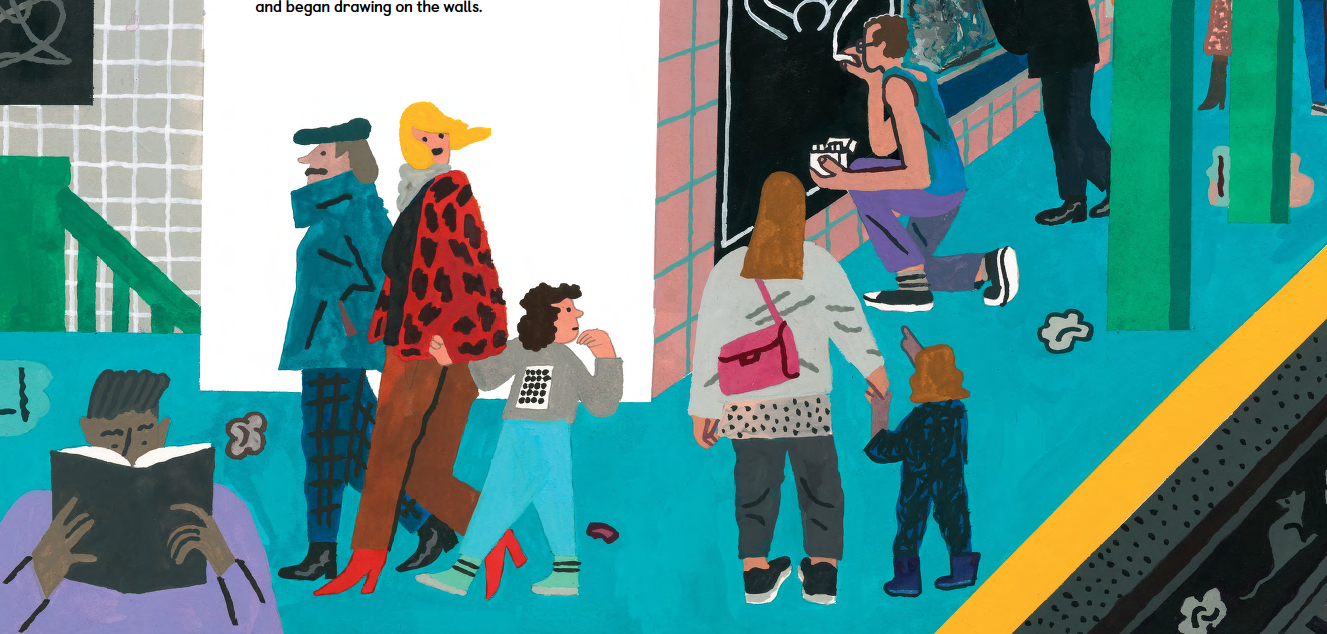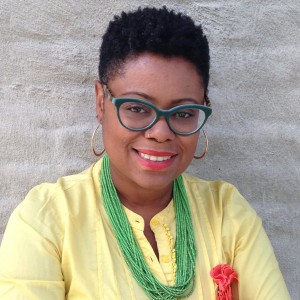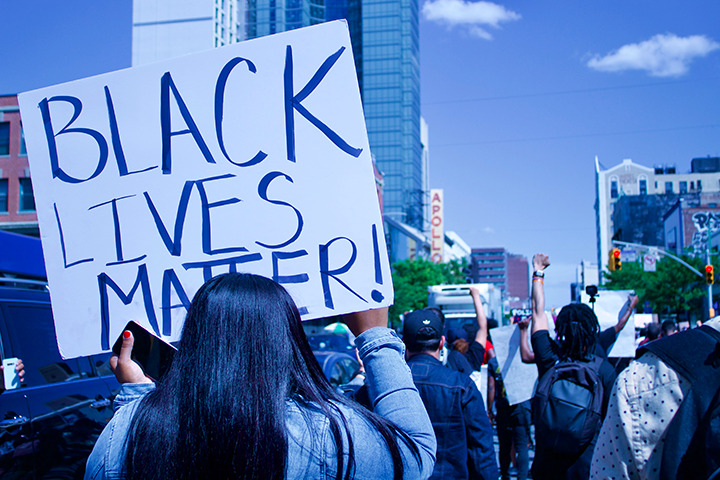Image by Josh Cochran from Drawing on Walls: A Story of Keith Haring.
So many students arrive in our classes with a narrow sense of what poetry is or can be. Among the preconceptions: poetry is hard, poetry is fancy, poetry is supposed to be pretty or profound. Of course, poetry can possess any of these qualities, but it also can be wild, rambunctious, irreverent, poly-vocal, multi-lingual, and funny. Often it’s not enough to merely repeat these assertions. As teachers, we can help students broaden their understanding of poetry’s possibilities with prompts that expand the field of play.
As a lead-in to this writing activity, which works well with middle school students through college and beyond, you might start with a brief conversation about dreams: their seeming irrationality, the elasticity of time and space, the surreal imagery. I would avoid a situation where multiple students begin recounting their own dreams aloud, since this could interrupt the forward momentum. The point is to establish that, as far as dreams are concerned, anything goes.
Then, depending on the length of your class meeting, you can share one or two poems as mentor texts: Wallace Stevens’ “Disillusionment of Ten O’Clock” and Harryette Mullen’s “Black Nikes.” Both encourage wordplay, imaginative leaps, and experimentation with form.
In the Stevens poem, we notice the speaker’s impatience with those conventional, white-nightgown-wearing people who “are not going / To dream of baboons and periwinkles.” The old sailor is the anti-hero who keeps the imaginative alive, the non-conformist who “[d]runk and asleep in his boots, / Catches tigers / In red weather.” Mullen’s prose poem, though not explicitly about a dream, is teeming with sudden, dream-like shifts in sound and image. “Time to throw down and take off on our launch. This flight will nail our proof of pudding. The thrill of victory is, we’re exiting earth. We’re leaving all this dirt.” Popping with puns and wordplay, Mullen’s poem concludes with a launch into the unknown—a fitting transition for the activity that follows. Though both of these poems warrant and reward a closer reading, I think it’s best not to spend too much time analyzing at this point. As one of my teacher-heroes, Corita Kent, advised: “Don’t try to create and analyse at the same time. They’re different processes.”
- The initial steps of the exercise may seem very structured, but they provide the foundation for the outlandishness to come. Ask students to open to two blank pages in their notebooks, or to use two sheets of paper. On one side or sheet, we are going to make a list. (Leave the other blank for now.) You might emphasize specificity and concrete detail before you begin the list. For instance: “If I ask you to choose an animal, “chihuahua” might be more interesting or more vivid than “dog.” Then read each category aloud (or invent your own!) and invite students to jot down the first word or phrase that comes to mind. Move at a pace which encourages spontaneity without applying undue stress. (If you are working with younger students, you can adapt and shorten the list so that it feels well-suited to their age and interests.)
- A faraway place.
- An unusual color.
- A beverage.
- A historical figure.
- A body of water.
- A celebrity.
- An underwater creature.
- An item on a breakfast menu.
- A juicy “verb.”
- A big number.
- A mode of transportation.
- A word in a language other than English.
- The first and last name of your first kiss or crush.
- An exclamation!
- A kind of weather.
- A lyric or line from a song.
- A famous author or writer or musician.
- A saying that you might hear in your house or neighborhood.
- A dream job.
- A type of footwear.
- An SAT word.
- A mythological character.
- Something your grandma or grandpa might say.
2. Once the lists are written, give a brief pause for students to catch their breath and shake out their hands—but not too long to lose the buzzing atmosphere that writing the lists has created.
3. Set a timer for 5-7 minutes. Now, ask students to begin with the phrase “Last night I dreamed…” Then—on the blank side or sheet, with the lists visible—free-write a “dream poem” using all the words and phrases on the list. Students can choose whether they want to experiment with line breaks like Stevens or try their hand at a dense and rollicking prose poem like Mullen. The main thing is to invite students to jump in, pulling from the list any words and phrases that seem to wink at them. Emphasize that the dreams they describe can be wild and do not need to make sense. “Don’t worry about spelling or punctuation,” I remind them. “Break lines or don’t break lines. Just go. Have fun. See what happens. Don’t stop to think—the goal is to keep your hand moving and to see if you can use every item on your list.”
4. Write your own dream poem, if possible, and occasionally look up to notice the quality of concentration in the room. If the timer is about to sound but everyone is still writing, extend the time allotment. Before you conclude, give students a one-minute heads-up. I tend to use a soft voice here, especially if writers are still in the flow: “If you are still working, keep going. If you are finished, read through what you wrote and see what happened. If you get an idea for a stronger word or a way to make an image or line more vivid, go for it, but don’t worry about spelling or grammar or making sense.” I reiterate these permissions because some students need repeated assurance.
5. Finally, invite volunteers to read their spontaneous “dream poems” aloud. In my classes, we all snap when someone finishes reading.
I often conclude this lesson with some possible suggestions for revision. What would happen if you shifted all of the verbs to the present tense? What if you dropped the initial phrase—“Last night, I dreamed…”—and allowed the reader to enter the poem without being explicitly told that it is a description of a dream? My intention is to highlight that even subtle adjustments will alter or shift the poem’s particular effects. The goal is not to craft a perfect dream—it is to encourage students to play on the page with greater freedom. I want them to know that Beyoncé can appear in a poem, that they can blend and sample and shout in a poem, that they can shake off logic and self-censorship and let themselves levitate—or launch!
Here are some recent student examples:
Last night I dreamed
–Jocelyn Jeffery
of Billie Holiday in Paris
Drinking almond lattes against
an azure sky
Rosa Parks across the Atlantic
ate coconut yogurt and fruit with an octopus
I swept Bradley Cooper away on a moped in moccasins
Oh my heavens, I’m in the mood for love
A regularly published author
Usurped the balmy nuit
it was the Tyrant Medusa, who also
Kissed Wren Rafferty
full of FOMO
Yikes, one hundred times
Last night I dreamed of a sea turtle in the Baltic swimming south to Myanmar where azure waters phosphoresce under overcast eyes. Louis Pasteur was there, mixing avocado milk, and John Berger came by on a scooter. Woof! That’ll be 282,320 pounds, said Louis to John. Molto bene, he replied and picked out a cantaloupe to complement. Just then Willem Dafoe, sitting atop brolic Pegasus, swooped in wearing moccasins. Louis said, have some chocolate, but Willem was feeling parsimonious. He turned to Marissa Linkowski and sang, Salt the stoop and scoop the cat in / Snow is falling in Manhattan, and at that moment a peach landed at their feet, thrown by some baseball player down the block.
–Emmett Lewis
Last night I dreamed….
–Ania O., 7th Grade
I was in Hawaii on my porch drinking tea
While watching the most “hermosa” Pacific Ocean
In the hot sun I then spot Barack Obama swimming with dolphins,
screaming on the top of his lungs saying, “I’m proud of who I am!”
I quickly rub my eyes with disbelief
I then open my eyes to see that I was on a Fairy
Standing right in front of Beyonce
She looks down at me and asks, “What do you want to be when you grow up?”
I stood there frozen,
“Well, answer the question,” she says, “Don’t look at me like cow bust rope!”
I quickly took myself out of the trance and said,
“I would like to be a chef, one day.”
“Okay, well don’t go down without a fight, okay?”
Before I could answer,
10,000 birds fly over my head over the most beautiful turquoise ocean
Suddenly…“Hey, are you okay?”
I then wake up to find that it was only a dream
“Come let’s go have some French toast.”
Matthew Burgess is an Associate Professor at Brooklyn College. He is the author of eight children's books, most recently The Red Tin Box (Chronicle) and Sylvester’s Letter (ELB). Matthew has edited an anthology of visual art and writing titled Dream Closet: Meditations on Childhood Space (Secretary Press), as well as a collection of essays titled Spellbound: The Art of Teaching Poetry (T&W). More books are forthcoming, including: As Edward Imagined: A Story of Edward Gorey (Knopf, 2024), Words With Wings & Magic Things (Tundra, 2025), and Fireworks (Harper Collins, 2024). A poet-in-residence in New York City public schools since 2001, Matthew serves as a contributing editor of Teachers & Writers Magazine.




